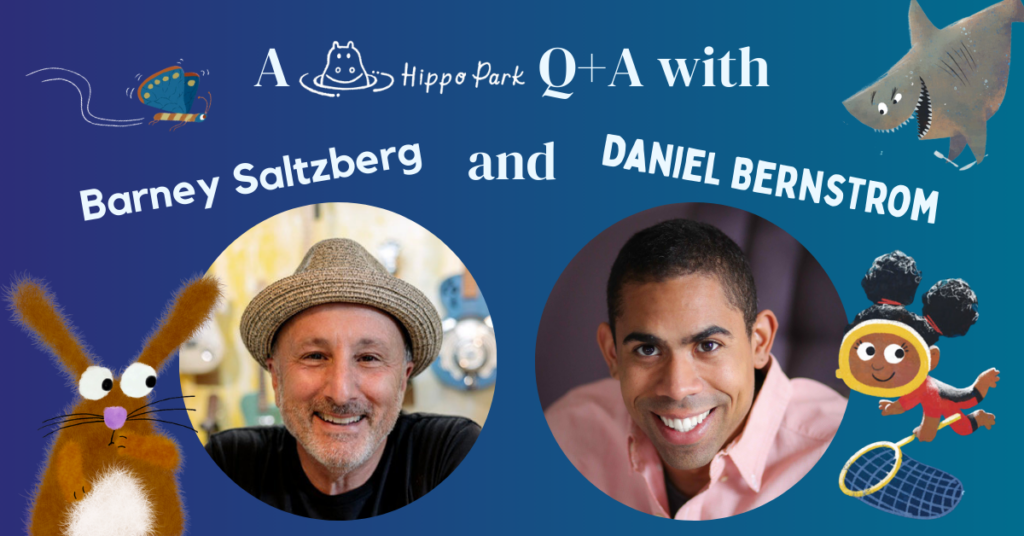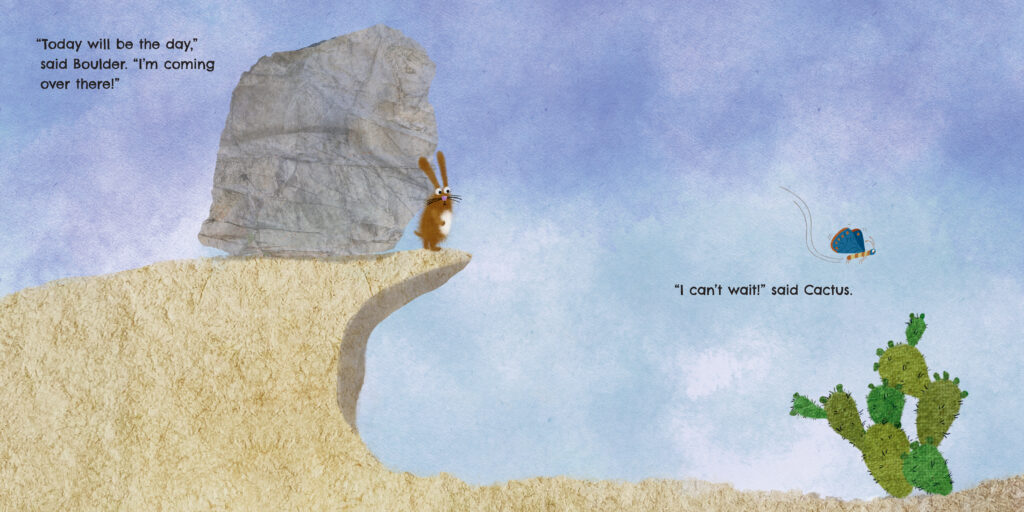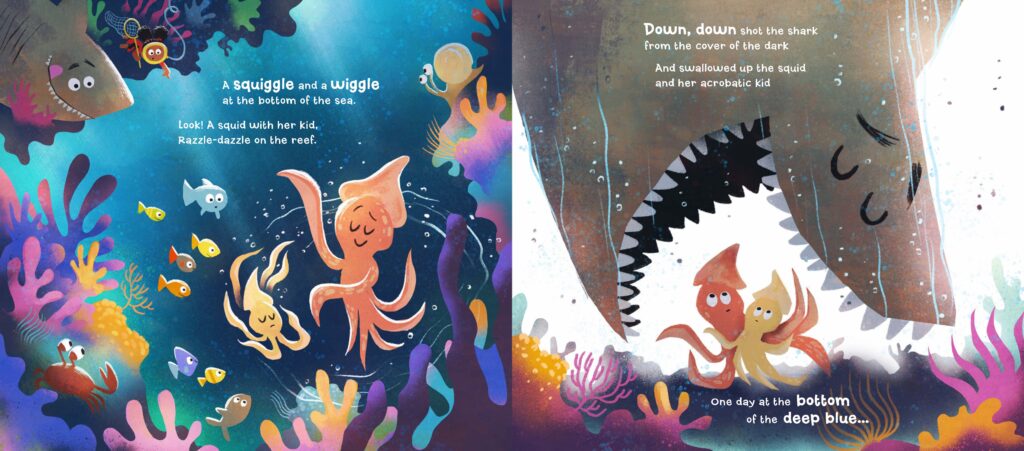A Joint Q&A with Hippo Park Creators Barney Saltzberg and Daniel Bernstrom!

In Barney Saltzberg’s new picture book Rabbit’s Feat, a single-minded rabbit channels his smarts and ingenuity to finally unite long-time friends Boulder and Cactus. Miles and miles away, a bright and brave little girl shrewdly avoids becoming a hungry shark’s dinner in Daniel Bernstrom’s picture book One Day at the Bottom of the Deep Blue Sea. Read on to learn more the creators of these two books, and discover their inspirations and creative processes.
1. Tell us more about your book! What inspired you to tell these tales?
DANIEL BERNSTROM: My book? It’s a modern-day folktale, plain and simple. I’ve always admired Kipling and his way of weaving human and animal interactions in nature. Now, a real folktale isn’t about some neat, tidy story. It’s about sparking bigger questions. My book is full of them—questions about nature, about why Mister Shark transforms, and so much more. It’s about pushing readers to think about our role with nature, what it means to be human in a moral sense, and what power we have against relentless threats. I believe all stories have a moral core—John Gardner said something like that, I think. And by moral, I mean exploring right and wrong. A good story, even a picture book, doesn’t give you easy answers. It dives into the gray areas, where light and darkness mix. Folktales are the perfect vehicle for this. They’re fun, funny, sometimes outrageous, even a little inappropriate—but that’s the point. Kids are smarter than we think. They need these kinds of stories, these oral folktales, that challenge them to grapple with what it means to be human.
BARNEY SALTZBERG: I don’t have a really definitive answer. I was playing with some photos I took of handmade paper and a boulder appeared. It looked like it should be in the desert and that meant adding a cactus. Somehow a conversation developed between the boulder and the cactus and I loved the idea of them wanting to be closer. That in and of itself seemed like an impossibility. I needed a character to help them realize their dream of being closer and I loved the idea of the rabbit being a silent helper. This is a story of service and doing the right thing.
2. Although they have different tones, each of your books emphasizes the power of perseverance. What drew you to work with this powerful theme?
DB: It’s funny, I never consciously think, ‘Okay, today I’ll write about persistence.’ But it keeps showing up in my work, again and again. It’s like there’s an inherent rhythm in my writing, a kind of cadence that naturally carries this theme along with it. Think about it like this: different music genres have distinct signatures, right? Hip hop, for instance, has a unique feel—drums, synthetic sounds, spoken word. But within that genre, every artist brings their own flavor. You can often tell who’s making the music just by the beat, because it’s uniquely theirs. It’s the same with my stories. There’s a ‘beat’ to my writing, a rhythm that’s more than just the words on the page. It’s the underlying themes that resonate with that rhythm. And persistence? That’s one of the consistent themes that just fits with my ‘beat.’ It’s not forced; it’s simply part of the music I keep coming back to, a rhythm I can’t seem to shake.
BS: I think it’s really important, especially at this moment in time, to plant seeds for children of all ages. I wanted to show a story where a character decides to help just because it’s the right thing to do.
3. Each book follows someone small who, through dedication and resourcefulness, accomplishes something remarkable. How did you go about developing your main characters?
BS: I think that a small character is relatable for children. I think it’s normal to feel powerless as a child so why not write a story that models how powerful you can be, in spite of your size.
DB: Let’s go back to that “’invisible, metrical hand.” My writing’s meter is conversational, yet rhythmic, like song lyrics that follow the music of the voice. And from that music, the characters truly emerge. It’s like a unique voice that only comes into being when the story’s rhythm and my voice as the writer come together. There’s a musical term for this… polyphony, I think? It’s that idea that something special happens when different voices harmonize. The character of the girl? She’s that ‘third voice’ created from the ‘beat’ of my words and the core ideas of the story. Just like in hip hop, where the beat dictates the flow and creates a new song from the words and rhymes, the ‘beat’ of my book gave rise to this girl. Her speech, her actions, her character—it’s all shaped by that rhythm, moving in harmony with the persistent theme that echoes throughout the story. She’s not just in the story; she’s made of it.


4. There’s so much suspense in each of these stories. The reader can’t wait to learn how each plan turns out! How do you know when you’ve found the right ending?
DB: Ah, suspense! It all comes down to putting obstacles in the hero’s way, doesn’t it? In basic story structure, someone wants something desperately but can’t get it easily. In One Day at the Bottom of the Deep Blue Sea, we’ve got this wonderful little girl, she’s after a pearl. Down she goes with her net, and BOOM—a great white shark! Instant suspense. I think that taps into something primal, that fear of something hunting us in the darkness. But animals, even sharks, aren’t stereotypical monsters. They’re not simply ‘good’ or ‘bad.’ So, the suspense is really two-fold. First, will the girl get away? And then, after she gains the upper hand, will the shark be alright? Because he’s his own kind of hero, in a way. That sense of empathy for the shark, that’s what I think makes it a literary picture book. I don’t want to tell you how to feel. I want you to look into the book as if you would a mirror, like you’re looking at an abstract painting, and asking, ‘What is this inviting me to experience?’ That empathy made the ending a real challenge. I had an earlier version where the girl just… escaped. My editor pushed me to find something more, something special within her. When the illustrator made sure the girl grabbed that pearl before going back up, that’s when it all clicked. I realized I had to go on my own journey into the deep, into the heart of the story, to understand what I was trying so desperately to understand about life. The answer was there, all along. And so I had to face a question that’s been with me since childhood: What do you do when faced with an obstacle so big, so mighty, that you feel powerless, and all you have is just a silly net? The illustrator helped me see that she had more than the option of escape—she had human ingenuity. The net was a tool! And it was a uniquely human one. So, the true pearl isn’t just some shiny thing at the bottom of the sea. It’s the belief in your own capability, even when faced with Goliath-sized odds.
BS: With close to fifty published books, I ‘know’ when the ending works. It just felt right. It took a lot to get there, but now that it’s done, I know it works.
5. What do you most enjoy about writing for kids?
BS: I enjoy everything about writing and illustrating for children. Books are like little movies that I get to write, cast and direct. It is a phenomenal feeling to have a child (at any age) find a story that I have written that resonates with them.
DB: Joy. Pure wonder. The absolute best part of being a children’s book writer is reading to kids. When I read One Day at the Bottom of the Deep Blue Sea to a couple of elementary school classes, their excitement was infectious. They were hanging on every word, practically begging me to turn the page. But even more important than their reactions was listening to what they said, the questions they asked. I know I sometimes ruffle feathers with teachers and librarians because my author visits can get…boisterous. But I believe literacy isn’t fostered through quiet, well-behaved readings. It’s about letting the kids interact with text through language. So, I let them ask a million questions, even if they seem like ‘nothing’ questions. I let them tell me about the time their hair turned purple! Kids are wonder. They embody that joyful, unrestricted wonder, and being part of that is what makes this job so unique. Honestly, those kids are often better writers than I am. They’re brilliant. I actually need to talk to my editor about revisiting an ending to one of my books—they saw something I missed. But that kind of magic only happens when we engage with a book in a vibrant way, when we invite literary analysis and exploration. I get so excited about this. If people read my books to kids, I hope they’ll let the kids take the lead, let them ask questions, and truly listen as they wonder and explore the themes within the story.
6. Can you give us a sneak peek of your next project?
DB: Alright, alright, alright, listen to this—I’m working on the most joyful book about donuts! Okay, okay, okay, so get this: there’s this donut man. I know, right? A DONUT MAN! It already sounds amazing, doesn’t it?! Okay, so he (the donut man!) has got a donut van, see? He sells donuts right out of his van. But then—and this is where it gets wild—a bear sneaks into the van without the donut man even noticing! Okay?! Then, the donut man drives off with a bear hiding in the back! Can you imagine what happens next?! It’s pure chaos—a bear and a man in a donut van full of donuts. You absolutely won’t believe the adventure that follows. Thanks for asking.
BS: I loved my first Hippo Park book, A Delicious Story. We decided those mice need a follow up book so I have been working on A Not So Scary Story, which brings the mice back and I love having the opportunity to work with them again!
We hope you enjoyed learning more about Daniel and Barney and their new books! Check out One Day at the Bottom of the Deep Blue Sea and Rabbit’s Feat below, and keep an eye out for more from each author!

Barney Saltzberg is the author of more than 30 books for children. He lives in Los Angeles with his wife, two dogs, and a pond full of fish. His books have won numerous awards, including NAPPA Gold Awards, and have received Publishers Weekly and Kirkus Reviews starred reviews.

Daniel Bernstrom is a visually impaired writer and poet who longs for every child to experience the music and tempo of a good story. He is the author of seven picture books, including A Bear, a Bee, and a Honey Tree and A Bear, A Fish, and a Fishy Wish. Daniel lives in Worthington, Minnesota, with his wife and their six children.



